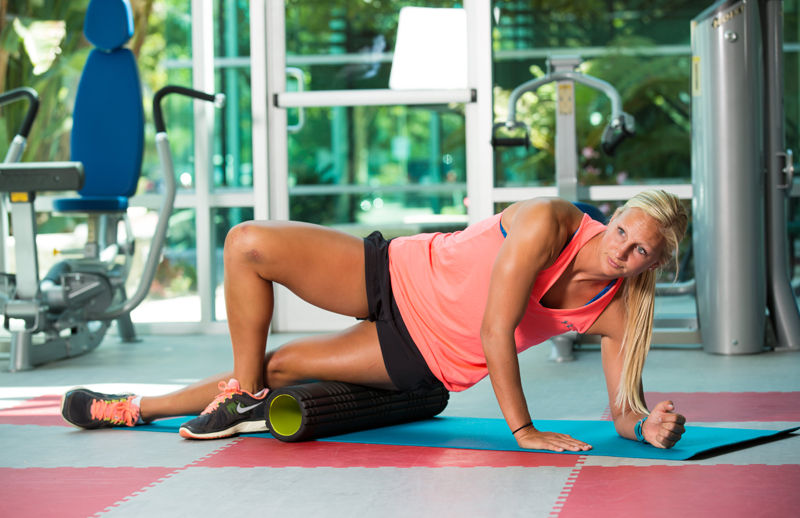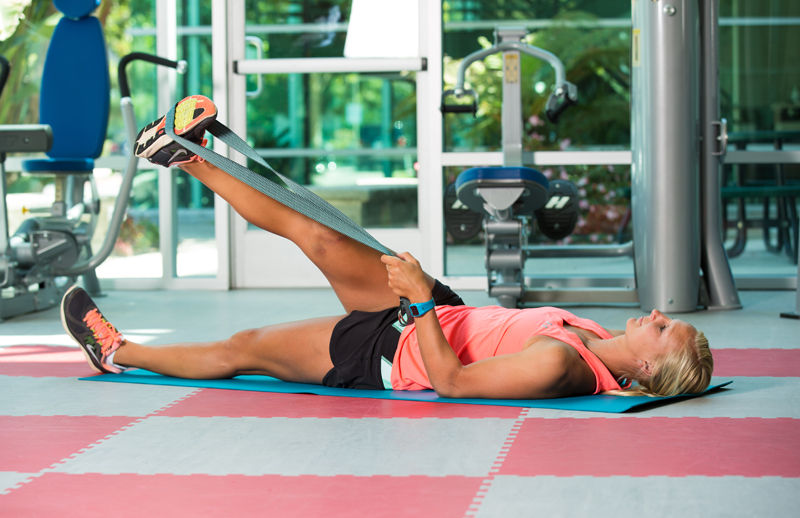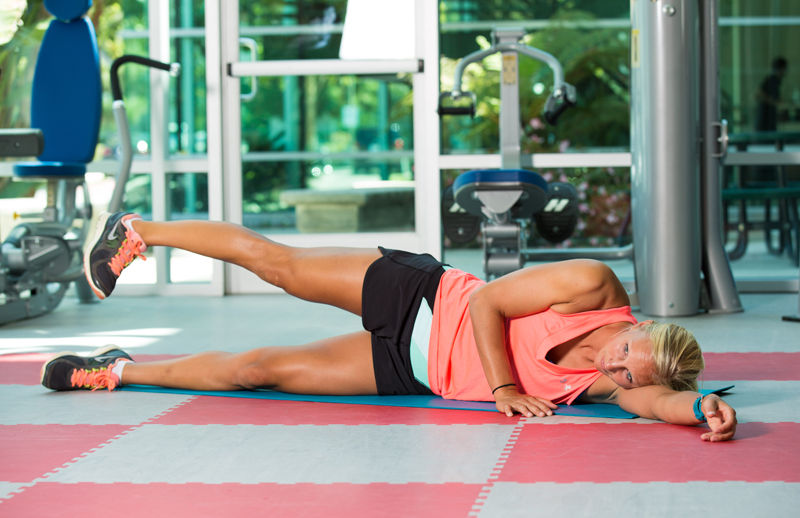The illiotibial band, or IT band, is a band of thick fibers that connect from the most prominent area of the hip bone (iliac crest) and runs laterally down the leg, attaching to the shin bone (tibia). It is formed by the fibers of the long tendon of the tensor fascia latae (TFL) and the lower fibers of the gluteus maximus, thus connecting the knee bone to the hip bone. The IT band coordinates muscle function and helps stabilize the knee during activities such as running. Because the IT band consists of thick fibers, it does not lengthen and contract like other skeletal muscles. Therefore, much of the discomfort results from friction along the bony structures or excessive tension from the TFL and gluteus maximus.
Long-distance runners and highly active individuals often experience IT band discomfort or syndrome due to high bouts of activity and persistently moving in the same plane of motion (sagittal plane). IT band discomfort and overuse may result in a snapping, sharp or painful shock in the lateral knee or hip. Lateral hip pain may result in more serious issues, such as greater trochanteric bursitis, if IT band self-care is not performed.
Every person experiences pain differently, but long-term discomfort may result in debilitating pain. If you experience pain or tenderness in the lateral region of the hip and knee joint, contact your orthopedic doctor or physical therapist, who can test the strength and flexibility of the IT Band, as well as evaluate your anatomical structure, to prescribe the best rehab methods. Below is an overview of what causes IT band issues and how you can perform self-care for these fibers.
What Causes IT Band Issues?
Overtraining: This includes overtraining in general or in a particular sport such as running. Overtraining, especially without proper nutrition, causes the body to break down. Runners who jog the same path every day, especially if it’s uneven, may be at greater risk for IT band issues because the body must adjust to the uneven terrain. Try cross training with lower-impact movements such as swimming, biking, yoga or Pilates.
Improper Running Technique/Faulty Movement Patterns: Many runners who have an improper gait or poor running technique, especially heel striking, will eventually experience pain due to ground-reaction forces that transfer up the kinetic chain. Pain is usually most severe when the heel strikes the ground. Discomfort is also recognized when walking up and down hills or stairs.
Muscle/Structural Imbalances: An individual who has an uneven pelvis, spinal cord misalignment, bowlegs or leg-length discrepancy may experience an overcompensation while in motion. Many desk workers experience muscle imbalances, including weak glutes or hamstrings, or muscle tightness, which contributes to irritation.
Failure to Stretch: Lack of stretching increases tightness in the lower extremity and decreases range of motion overtime.
Lack of Recovery Time: Similar to overtraining, if the legs are not allowed to rest and recover, the IT band may be one of the first discomforts that will be felt.
Improper Footwear: Shoes that do not properly fit, including work shoes worn throughout the day, may alter the landing position of the foot, or shift the pelvis out of alignment, which may place additional stress on the lower-extremity joints. It is important to find footwear that matches your gait pattern. A running store is an ideal place to get properly fitted.
What Self-care Can I Perform for the IT Band?
At home or in a gym, these simple strength and flexibility exercises ensure your IT band receives proper maintenance care. Discomfort and pain is the first signal that your body is not functioning properly, so it is ideal to maintain self-care so the discomfort doesn’t worsen.
IT Band Foam Rolling

The IT band is one of the most uncomfortable areas of the body to foam roll. If you are new to foam rolling, start by rolling out the calves, quadriceps, hamstrings and glutes prior to targeting the IT band. If you’re experienced with foam rolling, it may be time to “loosen” up the IT band by targeting that region. Start with a soft-surface foam roller before proceeding to a more dense foam roll. For those who experience lateral hip pain, check with your medical provider to see if foam rolling is acceptable. You should avoid foam rolling this area of the body if you have greater trochanteric bursitis. Applying direct pressure on the bursa will increase pain, but your health-care provider can provide guidance.
How to Perform: Lie on your side with the bottom elbow on the ground to support your body weight. Start at the bottom of the IT band and slowly move up the leg 2 inches, and then down 1 inch. Continue this motion until you reach the top and proceed back down the leg, down 2 inches, up 1 inch. Repeat on the other leg.
Extended Leg Twist With Strap

This is a deeper stretch and opens the gluteals and external rotators of the hip.
How to Perform: Lie on your back and place your right foot into a strap or towel. Hold the strap with the left hand and cross the leg over the body, or until a point where you feel a stretch. Think about pushing your foot into the strap to lengthen the lateral shin and deepen the stretch. Hold for 20 to 30 seconds and repeat on the left leg.
Seated Figure-4 Stretch

This stretch lengthens the lateral hip and external rotators of the hip, especially the piriformis. The pose is deeper when the torso is folded forward.
How to Perform: Sit on the edge of a chair and cross the right leg over the left thigh. Place your hands on the shin or inner thigh and apply slight pressure to feel the hip stretch. For a deeper stretch, lean forward with the torso and maintain neutral posture in the upper back. Hold for 20 to 30 seconds and repeat on the left leg.
Lateral Band Walks

This exercise strengthens the hips and gluteal muscles. When deepened into a squat, the hamstring and quadriceps muscles are strengthened as well.
How to Perform: Place a band of appropriate resistance around the shins, above the ankles. Start to walk laterally toward the left for 10 steps and then walk laterally to the right for 10 steps. Lower the legs into a squat for a better challenge. Complete two sets.
Side Leg Lift with Downward Pointed Toe

This exercise strengthens the lateral hip and targets the gluteus medius, which is a key stabilizing muscle that is often neglected.
How to Perform: Lie on your side, extend the bottom arm and rest your head into the biceps. Lift your top leg to hip height and rotate the foot inward, pointing the toe downward. Lift your top leg to a point where you feel a contraction and return to center. Repeat for 30 seconds and switch to the opposite leg.
What Should I Do if Pain Persists?
If pain persists, contact your local healthcare provider, who may have to run tests to determine if there are additional joint or muscular issues. However, if no pathology exists, one can seek alternative treatments through physical therapy, massage therapy or acupuncture to promote better function.




 by
by 




 by
by